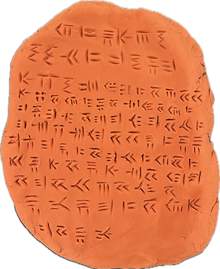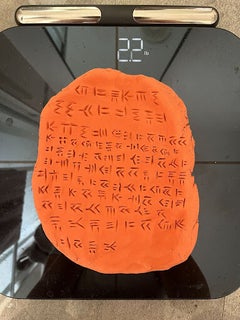A short project examining the pros and cons of using the ancient method of cuneiform
By Alexis Gerstenkorn
A short preface,
For this project we were asked to choose a form of ancient communication/ documentation and recreate it as faithfully as possible. After we were to asses some of the potential affordances and limitations to the medium based on our experiences.
An example of a cuneiform tablet written in the late Persian writing style in Babylonian age (left) along with my own tablet (right)

Last Fall I visited New York with my boyfriend for my birthday. During our trip we managed to stumble into the New York Public Library which at the time was hosting an expedition showcasing how literary work has evolved through the ages. Among those exhibits there was one that captured my attention almost immediately. In the glass case there was a collection of stone and clay tablets and other pottery. Some of the tablets had pictures carefully carved into them, similar to the Egyptian hieroglyphics, and some looked like the example above. This is the ancient art known as Cuneiform, a method of writing and communication in which symbols were carefully carved into stone tablets, as well as other clay pieces, such as tablets and pottery. This particular method was most commonly used by the Mesopotamian and Persian empire from around 3400- 550 BCE until the fall of the Babylonian empire in 330 BCE.
So when reading the details of this assignment I thought back to that expedition and decided that that would be a fun and easy project, especially considering that I already had the main component necessary, Clay. As you are about to read, I quickly learned a very humbling lesson.
The Process
See when I began this project I had to take a few… creative liberties. I wanted to create a tablet similar to the ones from the Persian empire, more specifically from the late Babylonian era, however the Persians often used stone. Now, I have zero access to a stone tablet and tools as well as zero experience in chiseling, so while I am very committed to my education I am certainly not that committed. So, to solve this I utilized the mesopotamia method of using clay slabs, which technically were also used in Persia, just rarely. I luckily had some terracotta air dry clay from a prior project which actually very closely resembles the actual terracotta clay that the Mesopotamians would have used. With that I kneaded the clay and rolled it out into a rectangular slab and got to work translating my message.
The message is as follows….
“To my sister, I agree to accompany her to the land of trade (the mall). In exchange a fee will be paid to feed my horses (gas money) and wine of the finest caliber (boba)”
The Cons
Now not to start on a negative note but I fear that there are quite a few limitations that I both experienced and considered while working,
Labor Intensive- the entire process, whether with stone or clay is very labor intensive. With clay, you must mix the clay, shape it, carve, and then either bake it or lay it in the sun to harden. With stone there is hauling and chiseling.
Despite the fact that I had the clay already pre made, rolling and flattening it took a good deal of effort.
Difficulty with transport- Whether stone or clay these tablets can be very large and heavy meaning that transporting and storing them could be difficult.
My own tablet was approximately the size of my hand and weighed about 2.2lb and considering that Cuneiform was often used to record trades, contracts, laws and stories I’m sure they can end up much larger than this.
Little room for mistake- This is especially true with stone. Mistakes are not so easily fixed and this could lead to a person having to start over.
Though I could more easily fix mistakes I made in the clay I still had to be extremely careful and more often than not ended up messing up my other letters.
Costly and time consuming- This process can take a long time to complete and you would have to take into the cost of tools (chisels, stone, clay, carved stamps) as well as have someone who is skilled in the art.
The entirety of this process (without making the clay or going out to purchase any tools) took about two hours. From kneading to rolling, translating, and engraving and as of now the clay is still drying.

A picture of the clay tablet I created weighing in at 2.2lb
The Pros
Well it can’t be all doom and gloom can it? Nope! There are some good advantages to consider.
Durability- these tablets are pretty durable, unlike paper they can survive floods, fires, and due to their weight they would be fairly difficult to steal. There's a reason we have a good understanding of how writing progressed from hieroglyphs to complex symbols in the Persian empire.
I dropped my tablet twice trying to weigh it. It was fine.
More artistic form of expression- When you think of it, especially with clay you can transform it into beautiful works of art while still maintaining its purpose
If I had more time I think I could have made a nice vase with the inscription on it instead
Cuneiform is a unique and beautiful style of communication that some still practice even today, and though it has its drawbacks I believe that the fact that it can last thousands of years letting us learn about ancient civilizations today makes it well worth it.
